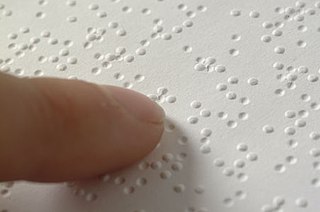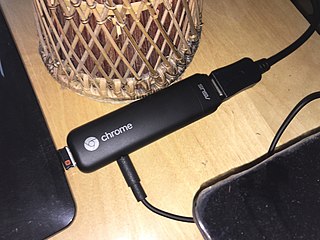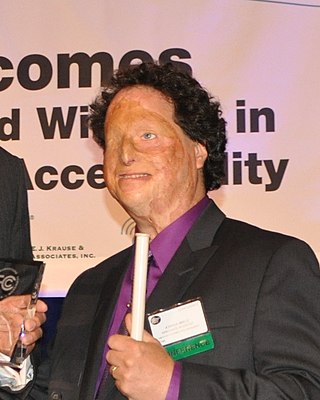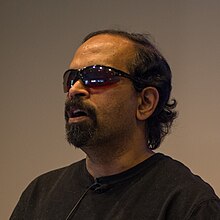
Braille is a tactile writing system used by people who are visually impaired, including people who suffer from low vision, blindness, or deafblindness. It can be read either on embossed paper or by using refreshable braille displays that connect to computers and smartphone devices. Braille can be written using a slate and stylus, a braille writer, an electronic braille notetaker or with the use of a computer connected to a braille embosser.

The Rubik's Cube is a 3-D combination puzzle originally invented in 1974 by Hungarian sculptor and professor of architecture Ernő Rubik. Originally called the Magic Cube, the puzzle was licensed by Rubik to be sold by Pentangle Puzzles in the UK in 1978, and then by Ideal Toy Corp in 1980 via businessman Tibor Laczi and Seven Towns founder Tom Kremer. The cube was released internationally in 1980 and became one of the most recognized icons in popular culture. It won the 1980 German Game of the Year special award for Best Puzzle. As of March 2021, over 450 million cubes had been sold worldwide, making it the world's bestselling puzzle game and bestselling toy. The Rubik's Cube was inducted into the US National Toy Hall of Fame in 2014.

A screen reader is a form of assistive technology (AT) that renders text and image content as speech or braille output. Screen readers are essential to people who are blind, and are useful to people who are visually impaired, illiterate, or have a learning disability. Screen readers are software applications that attempt to convey what people with normal eyesight see on a display to their users via non-visual means, like text-to-speech, sound icons, or a braille device. They do this by applying a wide variety of techniques that include, for example, interacting with dedicated accessibility APIs, using various operating system features, and employing hooking techniques.

A Rich Internet Application is a web application that has many of the characteristics of desktop application software. The concept is closely related to a single-page application, and may allow the user interactive features such as drag and drop, background menu, WYSIWYG editing, etc. The concept was first introduced in 2002 by Macromedia to describe Macromedia Flash MX product. Throughout the 2000-s, the term was generalized to describe browser-based applications developed with other competing browser plugin technologies including Java applets, Microsoft Silverlight.

David Breyer Singmaster was an American-British mathematician who was emeritus professor of mathematics at London South Bank University, England. He had a huge personal collection of mechanical puzzles and books of brain teasers. He was most famous for being an early adopter and enthusiastic promoter of the Rubik's Cube. His Notes on Rubik's "Magic Cube" which he began compiling in 1979 provided the first mathematical analysis of the Cube as well as providing one of the first published solutions. The book contained his cube notation which allowed the recording of Rubik's Cube moves, and which quickly became the standard.
Jeffrey David Ullman is an American computer scientist and the Stanford W. Ascherman Professor of Engineering, Emeritus, at Stanford University. His textbooks on compilers, theory of computation, data structures, and databases are regarded as standards in their fields. He and his long-time collaborator Alfred Aho are the recipients of the 2020 Turing Award, generally recognized as the highest distinction in computer science.
Unified English Braille Code is an English language Braille code standard, developed to permit representing the wide variety of literary and technical material in use in the English-speaking world today, in uniform fashion.

Srinivasan Keshav is an American-Canadian Computer Scientist of Indian descent who is currently the Robert Sansom Professor of Computer Science at the University of Cambridge.

David Pope Anderson is an American research scientist at the Space Sciences Laboratory, at the University of California, Berkeley, and an adjunct professor of computer science at the University of Houston. Anderson leads the SETI@home, BOINC, Bossa, and Bolt software projects.
Emacspeak is a free computer application, a speech interface, and an audio desktop. It employs Emacs, Emacs Lisp, and Tcl. Developed principally by T. V. Raman, it was first released in April 1995. It is portable to all POSIX-compatible OSs. It is tightly integrated with Emacs, allowing it to render intelligible and useful content rather than parsing the graphics ; its default voice synthesizer can be replaced with other software synthesizers when a server module is installed. Emacspeak is one of the most popular speech interfaces for Linux, bundled with most major distributions. In 2014, Raman wrote an article describing how the software's design was impacted by shifts in computer technology and its general usage over 20 years.

David Gries is an American computer scientist at Cornell University, United States mainly known for his books The Science of Programming (1981) and A Logical Approach to Discrete Math.
A self-voicing application is an application that provides an aural interface without requiring a separate screen reader. Self-voicing applications can be an important form of assistive technology, useful to those who have difficulty reading or seeing.

Werner Hans Peter Vogels is the chief technology officer and vice president of Amazon in charge of driving technology innovation within the company. Vogels has broad internal and external responsibilities.
Elizabeth D. "Beth" Mynatt is the Dean of the Khoury College of Computer Sciences at Northeastern University. She is former executive director of the Institute for People and Technology, director of the GVU Center at Georgia Tech, and Regents' and Distinguished Professor in the School of Interactive Computing, all at the Georgia Institute of Technology.
RoboBraille is a web and email service capable of converting documents into a range of accessible formats including Braille, mp3, e-books and Daisy. The service can furthermore be used to convert otherwise inaccessible documents such as scanned images and pdf files into more accessible formats. RoboBraille has been in operation since 2004 and currently serves thousands of user requests each month from users around the world. The service is available for free for strictly individual, non-commercial use. Institutional use by academic institutions is available through SensusAccess.

Chrome Remote Desktop is a remote desktop software tool, developed by Google, that allows a user to remotely control another computer's desktop through a proprietary protocol also developed by Google, internally called Chromoting. The protocol transmits the keyboard and mouse events from the client to the server, relaying the graphical screen updates back in the other direction over a computer network. This feature, therefore, consists of a server component for the host computer, and a client component on the computer accessing the remote server. Chrome Remote Desktop uses a unique protocol, as opposed to using the common Remote Desktop Protocol.
Alternative formats include audio, braille, electronic or large print versions of standard print such as educational material, textbooks, information leaflets, and even people's personal bills and letters. Alternative formats are created to help people who are blind or visually impaired to gain access to information either by sight, by hearing (audio) or by touch (braille).

The Chromebit is a stick PC running Google's ChromeOS. It is able to be plugged into any display via HDMI to act as a personal computer. Keyboards and mice are able to be connected over Bluetooth or Wi-Fi. The device was announced in April 2015 and began shipping November 2015.

Joshua A. Miele is an American research scientist who specializes in accessible technology design. Since 2019, Miele has been Principal Accessibility Researcher at Amazon Lab126, a subsidiary of Amazon that works on hardware products. Before joining Amazon, Miele conducted research on tactile graphics and auditory displays at the Smith-Kettlewell Eye Research Institute in California for fifteen years. He has been blind since early childhood.












